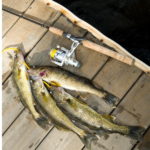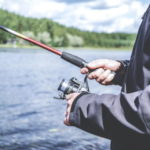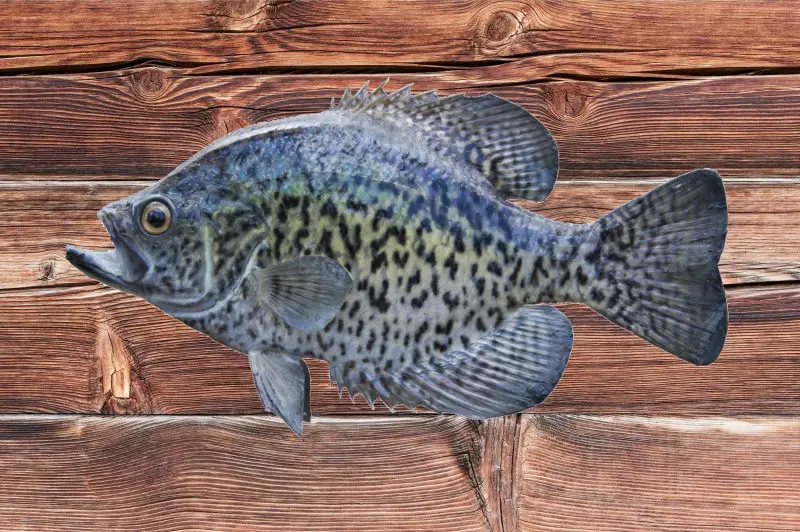Experienced anglers and casual recreationists alike love to fish for crappie. They are an abundant species and are spirited when on the hook. Catching and reeling them in can be challenging at times, which leads people to wonder if crappie are line shy.
Crappie aren’t line shy, but they are smart enough to know that human presence is dangerous for them. Other factors that influence the crappie’s reluctance to take the bait are environmental factors and biological characteristics. These factors include water temperature and spawning times.
In this article, I’ll dive into crappie behavior and characteristics that can contribute to their reluctance to take the bait. I’ll also talk about several things you can do to be prepared before even dropping a line in the water to help ensure your success when fishing for crappie.
Note: most links in this article are Amazon.com Affiliate links, see Affiliate Disclosure, thank you.
Reasons the Crappie May Not Be Biting
There are several reasons crappie may not be taking the bait, even if you’re at the right place, at the right time, and using the best methods.
You’re Standing Too Close
Crappie can act skittish at times. Common reasons for this skittishness may be the line you’re using, but crappie are also deterred if they sense human presence.
One of the things that can make crappie less likely to take the bait is being too close to them. They are quick to identify humans and human activities as a threat.
Generally, it’s best to get close enough to locate where crappie congregate, then back away a bit before throwing out your first cast. Waiting a few minutes between when you back away from your target fishing area and throwing out your first cast is also advisable.
Most people recommend using a properly rigged line that’s strong enough to hold the weight of the fish that’s transparent or in a color that the fish can ignore in the water. A clear or naturally colored line makes it easier to lull the fish into a false sense of safety, so they’ll take the bait.
Too Low Water Temperature
Water temperature is a significant factor in crappy behavior. This is likely due to spawning instincts triggered by water temperature. Midwest Outdoors tells us that crappie spawn occurs between 60 and 70 degrees, so watching your water temperature is crucial once you pass the mid 50’s.
As with other fishing gear, you want to choose a thermometer that fits the application. My favorite is the Aventik Fly Fishing Water Thermometer, which you can find on Amazon.com. It comes on a carabiner, can be tied to a line to test water temps at depth, and is an excellent value overall.
Barometric Pressure Changes
Pressure changes also are attributed to crappie behavior, explicitly becoming more active and feeding more aggressively. Some experienced anglers cite barometric pressure changes as the most significant factor influencing crappie behavior.
The fish don’t seem to have any clear preference when it comes to pressure, and there’s no conclusive evidence indicating if rising or falling pressure is better for crappie biting. The simple change in pressure encourages feeding behaviors, which can work to your advantage when fishing for crappie. Watch your local weather feed for changes in barometric pressure and the time your fishing trips accordingly.
Crappie Behavior and Characteristics
Depending on where you are fishing, there are two types of crappie; black and white. They’re very similar in behavior and biology. Crappie choose habitats in calm, warm locations for spawning, then move to deeper habitats after spawning.
Crappie Behavior When Spawning
According to the US Fish & Wildlife Service, crappie spawn in the spring. Males choose the spawning location, build the nest for the eggs, and then guard the eggs for roughly five days until the crappie fingerlings emerge.
This spawning behavior in the spring makes it a great time to fish for crappie. During this period, the fish are relatively abundant in shallow, warm water and hang around the nest for days until the juvenile fish hatch and leave the nest. This behavior makes them a great species to target for spring fishing.
Crappie Feeding Behavior
Understanding how and what crappie eat, particularly during the spawn, can help you better understand their behavior and thus, target the species when fishing. Crappie eat insects, small plant species, and small crustaceans. They also rely on juvenile predator species.
Juvenile fish that comprise the bulk of the crappie diet include bass, walleye, and pike, to name just a few. Minnesota DNR shares that these predator species also spawn in the spring, so crappie feeding behavior will be more aggressive when juvenile species are present.
When protecting their eggs, crappie will be less inclined to stray far from the nest. As an angler, if you can find where crappie are congregating during the spring spawn, not spook them, and drop the right bait in the water to entice them, your chances of hooking many fish are excellent.
General Crappie Behavior
Crappie are one of the fish species that are frequently found in a school, according to Idaho Fish & Game. If you see one crappie when you’re out fishing, chances are excellent that there are others nearby as well.
An excellent method to locate crappie is to locate habitats for small species or bait fish. Minnows and juvenile species can often be found in brushy waters or near fallen logs, near rocky drop-offs with many cracks and crevices, and in other places with plenty of cover from more prominent species.
If you locate bait fish or look in places with abundant freshwater vegetation, you’ll frequently find crappie lingering in the area. Once you’ve located the crappie, their habitat or the nearby bait fish can also help you determine which bait and tackle to use.
Conclusion
Crappie fishing is fun and exciting and can result in a tasty dinner, but it does require some planning and forethought. Be mindful of the weather, time of year, and proximity to fish, and keep from doing anything to startle fish and aquatic prey species. You’ll find success crappie fishing every outing with a bit of practice.





